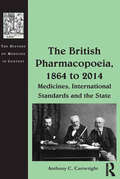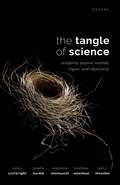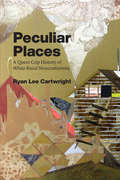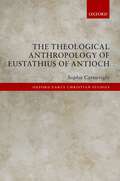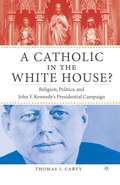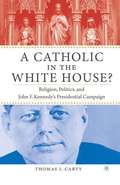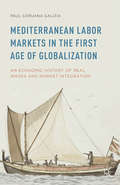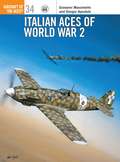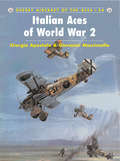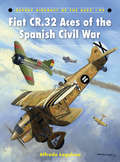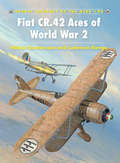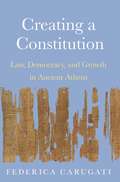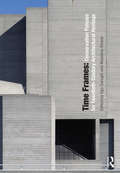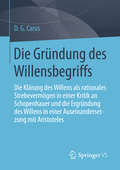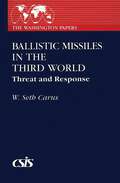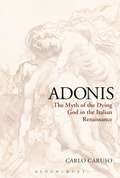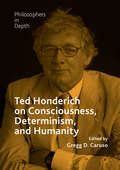- Table View
- List View
The British Pharmacopoeia, 1864 to 2014: Medicines, International Standards and the State (The History of Medicine in Context)
by Anthony C. CartwrightThe British Pharmacopoeia has provided official standards for the quality of substances, medicinal products and articles used in medicine since its first publication in 1864. It is used in over 100 countries and remains an essential global reference in pharmaceutical research and development and quality control. This book explores how these standards have been achieved through a comprehensive review of the history and development of the pharmacopoeias in the UK, from the early London, Edinburgh and Dublin national pharmacopoeias to the creation of the British Pharmacopoeia and its evolution over 150 years. Trade in medicinal substances and products has always been global, and the British Pharmacopoeia is placed in its global context as an instrument of the British Empire as it first sought to cover the needs of countries such as India and latterly as part of its role in international harmonisation of standards in Europe and elsewhere. The changing contents of the pharmacopoeias over this period reflect the changes in medical practice and the development of dosage forms from products dispensed by pharmacists to commercially manufactured products, from tinctures to the latest monoclonal antibody products. The book will be of equal value to historians of medicine and pharmacy as to practitioners of medicine, pharmacy and pharmaceutical analytical chemistry.
The British Pharmacopoeia, 1864 to 2014: Medicines, International Standards and the State (The History of Medicine in Context)
by Anthony C. CartwrightThe British Pharmacopoeia has provided official standards for the quality of substances, medicinal products and articles used in medicine since its first publication in 1864. It is used in over 100 countries and remains an essential global reference in pharmaceutical research and development and quality control. This book explores how these standards have been achieved through a comprehensive review of the history and development of the pharmacopoeias in the UK, from the early London, Edinburgh and Dublin national pharmacopoeias to the creation of the British Pharmacopoeia and its evolution over 150 years. Trade in medicinal substances and products has always been global, and the British Pharmacopoeia is placed in its global context as an instrument of the British Empire as it first sought to cover the needs of countries such as India and latterly as part of its role in international harmonisation of standards in Europe and elsewhere. The changing contents of the pharmacopoeias over this period reflect the changes in medical practice and the development of dosage forms from products dispensed by pharmacists to commercially manufactured products, from tinctures to the latest monoclonal antibody products. The book will be of equal value to historians of medicine and pharmacy as to practitioners of medicine, pharmacy and pharmaceutical analytical chemistry.
The Tangle of Science: Reliability Beyond Method, Rigour, and Objectivity
by Nancy Cartwright Eleonora Montuschi Jeremy Hardie Matthew Soleiman Ann C. ThresherScience is remarkably reliable. It puts people on the moon, performs laser eye surgery, tells us about ancient civilizations and species, and predicts the future of our climate. What underwrites this reliability? This book argues that the standard answers—the scientific method, rigour, and objectivity—are insufficient for the job. Here we propose a new model of science which places its products front and centre. In The Tangle of Science we show how any reliable piece of science is underpinned by a vast, diverse, and thick network of other scientific products. In doing so we bring back into focus areas of science that have been long neglected, emphasizing how every product, from the screws that hold the space shuttle together, to ways of measuring the consumer price index, to Einstein's theory of general relativity, work together to support results we can trust.
The Tangle of Science: Reliability Beyond Method, Rigour, and Objectivity
by Nancy Cartwright Eleonora Montuschi Jeremy Hardie Matthew Soleiman Ann C. ThresherScience is remarkably reliable. It puts people on the moon, performs laser eye surgery, tells us about ancient civilizations and species, and predicts the future of our climate. What underwrites this reliability? This book argues that the standard answers—the scientific method, rigour, and objectivity—are insufficient for the job. Here we propose a new model of science which places its products front and centre. In The Tangle of Science we show how any reliable piece of science is underpinned by a vast, diverse, and thick network of other scientific products. In doing so we bring back into focus areas of science that have been long neglected, emphasizing how every product, from the screws that hold the space shuttle together, to ways of measuring the consumer price index, to Einstein's theory of general relativity, work together to support results we can trust.
Peculiar Places: A Queer Crip History of White Rural Nonconformity
by Ryan Lee CartwrightThe queer recluse, the shambling farmer, the clannish hill folk—white rural populations have long disturbed the American imagination, alternately revered as moral, healthy, and hardworking, and feared as antisocial or socially uncouth. In Peculiar Places, Ryan Lee Cartwright examines the deep archive of these contrary formations, mapping racialized queer and disability histories of white social nonconformity across the rural twentieth-century United States. Sensationalized accounts of white rural communities’ aberrant sexualities, racial intermingling, gender transgressions, and anomalous bodies and minds, which proliferated from the turn of the century, created a national view of the perversity of white rural poverty for the American public. Cartwright contends that these accounts, extracted and estranged from their own ambivalent forum of community gossip, must be read in kind: through a racialized, materialist queercrip optic of the deeply familiar and mundane. Taking in popular science, documentary photography, news media, documentaries, and horror films, Peculiar Places orients itself at the intersections of disability studies, queer studies, and gender studies to illuminate a racialized landscape both profoundly ordinary and familiar.
Peculiar Places: A Queer Crip History of White Rural Nonconformity
by Ryan Lee CartwrightThe queer recluse, the shambling farmer, the clannish hill folk—white rural populations have long disturbed the American imagination, alternately revered as moral, healthy, and hardworking, and feared as antisocial or socially uncouth. In Peculiar Places, Ryan Lee Cartwright examines the deep archive of these contrary formations, mapping racialized queer and disability histories of white social nonconformity across the rural twentieth-century United States. Sensationalized accounts of white rural communities’ aberrant sexualities, racial intermingling, gender transgressions, and anomalous bodies and minds, which proliferated from the turn of the century, created a national view of the perversity of white rural poverty for the American public. Cartwright contends that these accounts, extracted and estranged from their own ambivalent forum of community gossip, must be read in kind: through a racialized, materialist queercrip optic of the deeply familiar and mundane. Taking in popular science, documentary photography, news media, documentaries, and horror films, Peculiar Places orients itself at the intersections of disability studies, queer studies, and gender studies to illuminate a racialized landscape both profoundly ordinary and familiar.
The Theological Anthropology of Eustathius of Antioch (Oxford Early Christian Studies)
by Sophie CartwrightThis authoritative study explores Eustathius of Antioch's theological anthropology, offering insight into one of the most important thinkers of the early Arian controversy. Sophie Cartwright situates Eustathius' thought in relation to the early 'Arian' controversy, the Constaninian Revolution, the theological legacies of Irenaeus and Origen, and the philosophical commentary tradition. She also locates Eustathius within his historical context and provides a detailed overview of the sources for his complex and fragmented corpus. Eustathius' anthropology is indebted to a tradition shaped by the theology of Irenaeus, that had already come into conversation with Origen. Dr Cartwright suggests that Origen's own thought was indebted to Irenaeus but that he had a radically different cosmology; this shaped subsequent engagement with both thinkers. Eustathius' theology of embodiment draws on Irenaeus, in opposition to what he perceives as the Origenist and Platonist anthropology which, in his anti-Arian works, he associates with Eusebius of Caesarea. However, he is deeply indebted to Origen for his doctrine of Christ's human soul and, consequently, his wider psychology. He places humanity at a great distance from God and seeks to give humanity autonomous value, especially in his discourse on God's image. This represents one logical negotiation of the rejection of Origen's eternal intelligible world. Eustathius' divisive Christology offers a picture of Christ as the perfect human being that echoes Irenaeus' Adam-Christ typology, fleshed out by an Origenian discourse on Christ's human soul and infused with a keen awareness of the chasm between God and humankind. He proffers a doctrine of inherited sinfulness as an alternative to Origen's doctrine of the fall and looks to a corporeal eschatological kingdom ruled over by the human Christ; this eschatology probably reflects discomfiture with Constantine's role in the church.
A Catholic in the White House?: Religion, Politics, and John F. Kennedy's Presidential Campaign
by T. CartyAccording to most political and religious scholars and pundits, JFK's victory in 1960 symbolized America's evolution from a Protestant nation to a pluralist community that included Catholics as all citizens. However, if the presidential election of 1960 was indeed a turning point for American Catholics, how do we explain the failure of any Catholic - in over forty years - to repeat Kennedy's accomplishment? In this exhaustively researched study that fuses political, cultural, social and intellectual history, Thomas Carty challenges the assumption that JFK's successful campaign for the Presidency ended decades, if not centuries, of religious and political tension between American Catholics and Protestants, paving a new role for Catholics in American presidential politics.
A Catholic in the White House?: Religion, Politics, and John F. Kennedy's Presidential Campaign (PDF)
by Thomas J. CartyAccording to numerous scholars and pundits, JFK's victory in 1960 symbolized America's evolution from a politically Protestant nation to a pluralistic one. The anti-Catholic prejudice that many blamed for presidential candidate Alfred E. Smith's crushing defeat in 1928 at last seemed to have been overcome. However, if the presidential election of 1960 was indeed a turning point for American Catholics, how do we explain the failure of any Catholic--in over forty years--to repeat Kennedy's accomplishment? In this exhaustively researched study that fuses political, cultural, social, and intellectual history, Thomas Carty challenges the assumption that JFK's successful campaign for the presidency ended decades, if not centuries, of religious and political tensions between American Catholics and Protestants.
Mediterranean Labor Markets in the First Age of Globalization: An Economic History of Real Wages and Market Integration
by Paul Caruana GaliziaScholars have studied the nineteenth century's unprecedented labor flows in global and specific country contexts, but have lacked a comprehensive analysis of the world's old economic core, the Mediterranean. This work provides answers to important questions, such as: If the Mediterranean labor market really was integrated, then why did globalization affect the Western and Eastern Mediterranean so differently? Why did wage inequality rise in the East while it fell in the rest of the labor-abundant periphery? More broadly, was low emigration from Iberia and the East to blame for the Mediterranean's failed integration with the fast-expanding global economy? This ground-breaking research relates these questions to ongoing historical debates on the intensity of intra-Mediterranean integration in goods and labor, to current heated debates on North African emigration to Europe, and to discussions on European economic integration more generally.
Italian Aces of World War 2 (Aircraft of the Aces)
by Richard Caruana Giorgio ApostoloFlying aircraft such as the Macchi 200-202, Fiat G.50 and biplane Fiat CR.42, the Italian fighter pilots were recognised by their Allied counterparts as brave opponents blessed with sound flying abilities, but employing under-gunned and underpowered equipment. Following the Italian surrender in September 1943, a number of aces continued to take the fight to the Allies as part of the Luftwaffe-run ANR, which was equipped with far more potent equipment such as the Bf 109G, Macchi 205V and Fiat G.55. Flying these types, the handful of ANR squadrons continued to oppose Allied bombing raids on northern Italy until VE-Day.
Italian Aces of World War 2 (Aircraft of the Aces #34)
by Richard Caruana Giorgio ApostoloFlying aircraft such as the Macchi 200-202, Fiat G.50 and biplane Fiat CR.42, the Italian fighter pilots were recognised by their Allied counterparts as brave opponents blessed with sound flying abilities, but employing under-gunned and underpowered equipment. Following the Italian surrender in September 1943, a number of aces continued to take the fight to the Allies as part of the Luftwaffe-run ANR, which was equipped with far more potent equipment such as the Bf 109G, Macchi 205V and Fiat G.55. Flying these types, the handful of ANR squadrons continued to oppose Allied bombing raids on northern Italy until VE-Day.
Fiat CR.32 Aces of the Spanish Civil War (Aircraft of the Aces)
by Richard Caruana Alfredo LogolusoThe CR.32 Falco was a handsome and highly manoeuvrable biplane fighter. During General Franco's fight with the Republicans for the control of Spain from 1936 – 39, no fewer than 477 CR.32s were involved, with an astounding 709 confirmed aerial victories, and an additional 320 kills claimed, for just 62 losses. As these statistics reveal, the CR.32 was the unrivalled master of the skies over Spain. By the war's end, the five leading aces of the conflict were all Spanish CR.32 pilots. Their exploits, and those of the other leading CR.32 aces, are examined for the first time in English in this exciting volume.
Fiat CR.32 Aces of the Spanish Civil War (Aircraft of the Aces #94)
by Richard Caruana Alfredo LogolusoThe CR.32 Falco was a handsome and highly manoeuvrable biplane fighter. During General Franco's fight with the Republicans for the control of Spain from 1936 – 39, no fewer than 477 CR.32s were involved, with an astounding 709 confirmed aerial victories, and an additional 320 kills claimed, for just 62 losses. As these statistics reveal, the CR.32 was the unrivalled master of the skies over Spain. By the war's end, the five leading aces of the conflict were all Spanish CR.32 pilots. Their exploits, and those of the other leading CR.32 aces, are examined for the first time in English in this exciting volume.
Fiat CR.42 Aces of World War 2 (Aircraft of the Aces)
by Richard Caruana Ludovico Slongo Håkan GustavssonThe Fiat CR.42, a logical development of the Fiat CR.32, was the last single-seat fighter biplane to be produced. It entered service with the Italian Regia Aeronautica in May 1939 before being exported to Belgium, Hungary and Sweden. Its combat debut came when the Belgian air force threw its fleet into action during the German invasion of the Low Countries on 10th May 1940. Despite being quickly overwhelmed, the Belgian pilots managed to make a number of aerial claims. The CR.42 became heavily involved in the fighting in North Africa and although it was gradually replaced by more modern fighters, it continued in a point defence and ground support role until the end of the war. Drawing on research from a range of sources, this book examines the extensive employment of the Italian fighter plane during the course of World War II.
Fiat CR.42 Aces of World War 2 (Aircraft of the Aces)
by Richard Caruana Ludovico Slongo Håkan GustavssonThe Fiat CR.42, a logical development of the Fiat CR.32, was the last single-seat fighter biplane to be produced. It entered service with the Italian Regia Aeronautica in May 1939 before being exported to Belgium, Hungary and Sweden. Its combat debut came when the Belgian air force threw its fleet into action during the German invasion of the Low Countries on 10th May 1940. Despite being quickly overwhelmed, the Belgian pilots managed to make a number of aerial claims. The CR.42 became heavily involved in the fighting in North Africa and although it was gradually replaced by more modern fighters, it continued in a point defence and ground support role until the end of the war. Drawing on research from a range of sources, this book examines the extensive employment of the Italian fighter plane during the course of World War II.
Creating a Constitution: Law, Democracy, and Growth in Ancient Athens
by Federica CarugatiA comprehensive account of how the Athenian constitution was created—with lessons for contemporary constitution-buildingWe live in an era of constitution-making. More than half of the world's constitutions have been drafted in the past half-century. Yet, one question still eludes theorists and practitioners alike: how do stable, growth-enhancing constitutional structures emerge and endure? In Creating a Constitution, Federica Carugati argues that ancient Athens offers a unique laboratory for exploring this question. Because the city-state was reasonably well-documented, smaller than most modern nations, and simpler in its institutional makeup, the case of Athens reveals key factors of successful constitution-making that are hard to flesh out in more complex settings.Carugati demonstrates that the institutional changes Athens undertook in the late fifth century BCE, after a period of war and internal strife, amounted to a de facto constitution. The constitution restored stability and allowed the democracy to flourish anew. The analysis of Athens's case reveals the importance of three factors for creating a successful constitution: first, a consensus on a set of shared values capable of commanding long-term support; second, a self-enforcing institutional structure that reflects those values; and, third, regulatory mechanisms for policymaking that enable tradeoffs of inclusion to foster growth without jeopardizing stability.Uniquely combining institutional analysis, political economy, and history, Creating a Constitution is a compelling account of how political and economic goals that we normally associate with Western developed countries were once achieved through different institutional arrangements.
Creating a Constitution: Law, Democracy, and Growth in Ancient Athens
by Federica CarugatiA comprehensive account of how the Athenian constitution was created—with lessons for contemporary constitution-buildingWe live in an era of constitution-making. More than half of the world's constitutions have been drafted in the past half-century. Yet, one question still eludes theorists and practitioners alike: how do stable, growth-enhancing constitutional structures emerge and endure? In Creating a Constitution, Federica Carugati argues that ancient Athens offers a unique laboratory for exploring this question. Because the city-state was reasonably well-documented, smaller than most modern nations, and simpler in its institutional makeup, the case of Athens reveals key factors of successful constitution-making that are hard to flesh out in more complex settings.Carugati demonstrates that the institutional changes Athens undertook in the late fifth century BCE, after a period of war and internal strife, amounted to a de facto constitution. The constitution restored stability and allowed the democracy to flourish anew. The analysis of Athens's case reveals the importance of three factors for creating a successful constitution: first, a consensus on a set of shared values capable of commanding long-term support; second, a self-enforcing institutional structure that reflects those values; and, third, regulatory mechanisms for policymaking that enable tradeoffs of inclusion to foster growth without jeopardizing stability.Uniquely combining institutional analysis, political economy, and history, Creating a Constitution is a compelling account of how political and economic goals that we normally associate with Western developed countries were once achieved through different institutional arrangements.
Time Frames: Conservation Policies for Twentieth-Century Architectural Heritage
by Ugo Carughi Massimo VisoneTime Frames provides a reconnaissance on the conservation rules and current protection policies of more than 100 countries, with particular attention to the emerging nations and twentieth-century architecture. The contributions illustrate the critical issues related to architectural listings, with a brief history of national approaches, a linkography and a short bibliography. The book also provides a short critical lexicography, with 12 papers written by scholars and experts including topics on identities, heritages, conservation, memories and the economy. By examining the methods used to designate building as heritage sites across the continents, this book provides a comprehensive overview of current protection policies of twentieth-century architecture as well as the role of architectural history.
Time Frames: Conservation Policies for Twentieth-Century Architectural Heritage
by Ugo Carughi Massimo VisoneTime Frames provides a reconnaissance on the conservation rules and current protection policies of more than 100 countries, with particular attention to the emerging nations and twentieth-century architecture. The contributions illustrate the critical issues related to architectural listings, with a brief history of national approaches, a linkography and a short bibliography. The book also provides a short critical lexicography, with 12 papers written by scholars and experts including topics on identities, heritages, conservation, memories and the economy. By examining the methods used to designate building as heritage sites across the continents, this book provides a comprehensive overview of current protection policies of twentieth-century architecture as well as the role of architectural history.
Die Gründung des Willensbegriffs: Die Klärung des Willens als rationales Strebevermögen in einer Kritik an Schopenhauer und die Ergründung des Willens in einer Auseinandersetzung mit Aristoteles
by D. G. CarusMit diesem Werk wird zum ersten Mal der Willensbegriff gegründet, indem der intellektuelle Wille im Unterschied und in Erweiterung von einem rein vorstellenden rationalen Willen deutlich erfasst wird. Es wird im Verhältnis zu den anderen Strebevermögen gezeigt, dass der intellektuelle Wille das Strebevermögen des Menschen vervollkommnet und somit das Gute der Praxis im erkennenden Subjekt liegt. Im ersten Teil wird der Wille als Strebevermögen bei Arthur Schopenhauer analysiert, um in einer Kritik aufzuweisen, dass der Wille ein rationales Strebevermögen ist. Im nächsten Schritt wird der rationale und gute Wille bei Aristoteles in seiner Bedingtheit durch die intellektuelle Tugend der Klugheit aufgezeigt und nachgewiesen, dass der intellektuelle Wille in Abgrenzung von einem vorstellenden rationalen Willen von Aristoteles nicht hinreichend erfasst worden ist. Abschließend wird erklärt, dass die sittliche Tugend kein Prinzip der Moralität sein kann und allein der intellektuelle Wille das Prinzip des Guten abgibt.
Ballistic Missiles in the Third World: Threat and Response (The Washington Papers)
by W. Seth CarusThe proliferation of ballistic missiles in the Third World has posed a new type of challenge to policy makers in the United States. More than twenty Third World countries either possess surface-to-surface missiles or are trying to develop or acquire them. Current trends suggest that the number of countries with missiles will increase in the 1990s and that the capabilities of the available systems will also grow. W. Seth Carus assesses the threat of such proliferation to United States military forces as well as those of its allies operating in the Third World. The book studies the military utility of these missiles to the countries that possess them and covers the various military responses of Third World countries to missile proliferation.Carus also examines the various attempts the United States has made to slow the proliferation of ballistic missiles. Washington has joined many of its allies in the Missile Technology Control Regime (MTCR), a suppliers agreement designed to restrict exports of missiles and missile technologies to the Third World. According to Carus, efforts have been made to persuade the Soviet Union, China and other countries to abide by the provisions of the MTCR. After discussing the bilateral talks with proliferating countries, Carus also analyzes the attempts made to derail specific missile programs and the difficulties involved in controlling missile technology.
Adonis: The Myth of the Dying God in the Italian Renaissance
by Carlo CarusoIn this detailed treatment of the myth of Adonis in post-Classical times, Carlo Caruso provides an overview of the main texts, both literary and scholarly, in Latin and in the vernacular, which secured for the Adonis myth a unique place in the Early Modern revival of Classical mythology. While aiming to provide this general outline of the myth's fortunes in the Early Modern age, the book also addresses three points of primary interest, on which most of the original research included in the work has been conducted. First, the myth's earliest significant revival in the age of Italian Humanism, and particularly in the poetry of the great Latin poet and humanist Giovanni Pontano. Secondly, the diffusion of syncretistic interpretations of the Adonis myth by means of authoritative sixteenth-century mythological encyclopaedias. Thirdly, the allegorical/political use of the Adonis myth in G.B. Marino's (1569-1625) Adone, published in Paris in 1623 to celebrate the Bourbon dynasty and to support their legitimacy with regard to the throne of France.
Adonis: The Myth of the Dying God in the Italian Renaissance
by Carlo CarusoIn this detailed treatment of the myth of Adonis in post-Classical times, Carlo Caruso provides an overview of the main texts, both literary and scholarly, in Latin and in the vernacular, which secured for the Adonis myth a unique place in the Early Modern revival of Classical mythology. While aiming to provide this general outline of the myth's fortunes in the Early Modern age, the book also addresses three points of primary interest, on which most of the original research included in the work has been conducted. First, the myth's earliest significant revival in the age of Italian Humanism, and particularly in the poetry of the great Latin poet and humanist Giovanni Pontano. Secondly, the diffusion of syncretistic interpretations of the Adonis myth by means of authoritative sixteenth-century mythological encyclopaedias. Thirdly, the allegorical/political use of the Adonis myth in G.B. Marino's (1569-1625) Adone, published in Paris in 1623 to celebrate the Bourbon dynasty and to support their legitimacy with regard to the throne of France.
Ted Honderich on Consciousness, Determinism, and Humanity
by Gregg D. CarusoThis collection of original essays brings together a world-class lineup of philosophers to provide the most comprehensive critical treatment of Ted Honderich’s philosophy, focusing on three major areas of his work: (1) his theory of consciousness; (2) his extensive and ground-breaking work on determinism and freedom; and (3) his views on right and wrong, including his Principle of Humanity and his judgments on terrorism. Grote Professor Emeritus of the Philosophy of Mind and Logic at University College London, Honderich is a leading contemporary philosopher of mind, determinism and freedom, and morals. The collection begins with a comprehensive introduction written by Honderich followed by fourteen original chapters separated into three sections. Each section concludes with a set of remarks by Honderich. Contributors include Noam Chomsky, Paul Snowdon, Alastair Hannay, Barbara Gail Montero, Barry Smith, Derk Pereboom, Paul Russell, Kevin Timpe, Gregg D. Caruso, Mary Warnock, Paul Gilbert, Richard J. Norman, Michael Neumann, and Saul Smilansky.
